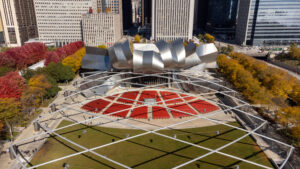by David Ferguson, Class of 2020
Photographs by the author
On July 16, 2024, Millennium Park celebrated its 20th anniversary, fairly quietly by Chicago standards.
Mayor Richard M. Daley first announced plans for Millennium Park in March, 1998. The projected price tag was $150 million, with $120 million to come from parking revenue bonds (funding public infrastructure) and the remainder to be provided through private donations for ‘enhancements’. Officially opening some four years late at a total cost of $490 million, with $220 million in private donations, the Park is considered a stunning success, on a number of fronts:
- Politically, Daley was able to bring all parties together and keep them focused. A possible dispute over the legal requirement to keep Grant Park “forever open, clear and free” was dismissed with the designation of the Pritzker Pavilion as art, rather than a building.
- Legally, it was determined that the Illinois Central Railroad did not own the land, but held simply an easement from the City, which they were prepared to release for tax benefits.
- Financially, the individual elements were funded from a wide array of public (for essential infrastructure), corporate and philanthropic (for key recreational structures) sources. Credit goes to John Bryan, then head of Sara Lee Corp. and a friend of Daley’s, for his fundraising efforts with corporate benefactors.
- Artistically, the Park is famous for its five prominent physical elements: Cloud Gate, the sculpture designed by Anish Kapoor; Crown Fountain, designed by Jaume Plensa, Lurie Garden, a showcase for scores of native perennials and grasses and, most prominently, the Jay Pritzker Pavilion and Serpentine Bridge, designed by Frank Gehry, with the accompanying, attached Harris Theatre, designed by Thomas Beeby.

Initial plans for a relatively simple grassy park were developed by Skidmore, Owings and Merrill in 1997, under the direction of principal Adrian Smith. The original plans for what was intended as a relocation of the more southern Petrillo band shell drew from the 1909 Plan of Chicago and reflected a Beaux-Arts theme. When presented to potential benefactor Cindy Pritzker, her reaction, reportedly, was: “Which millennium are you all talking about?” At the risk of losing the project, Smith suggested asking Frank Gehry, known to Pritzker for winning the 1989 Pritzker Architecture Prize, to design the proscenium of the relocated band shell. Gehry, a hot ticket with the 1997 opening of his Guggenheim Bilbao in Spain, gradually expanded the scope of his assignment to include: the building shell, integrated with Beeby’s Harris Theatre; the innovative trellis containing a state-of-the-art speaker system; and, the Serpentine, the bridge crossing Columbus Drive. What was originally planned as a $15 million project funded by Pritzker ultimately became a $60 million Chicago landmark.

Born in Toronto, Canada, in February 1929, Gehry and his family moved to Los Angeles in 1947. He received his Bachelor of Architecture degree from USC in 1954 and established his own practice in 1962. Gehry’s style of architecture is often classified as deconstructivist, a post-modern variant that accentuated the fragmentation of a constructed building. Gehry himself generally disavows any ‘school’ designation other than post-modern or contemporary. Perhaps the most significant influences can be attributed to his grandparents. To his grandmother, for the iridescent scales of live carp in the family bathtub, mesmerizing the young Gehry before being made into gefilte fish. Or to his grandfather, for the curls of shaved wood on the floor of his hardware store, which Frank often played with, building imaginary houses and futuristic cities.
Whatever the early influences may have been, Frank Gehry, among many others, has been a key contributor to the creation of an iconic Chicago landmark, once again confirming Chicago as the City of Architecture.

Given the significance of the Park…
- as a stunning example of urban revitalization which has promoted two decades of both residential and commercial redevelopment in the Loop;
- as a central downtown meeting place for both residents and visitors;
- as the home of Chicago’s only Frank Gehry structure and, for CAC docents;
- as the final stop on the Icons: Connecting Past and Present walking tour,
the reserved birthday party is surprising. Arguably, Millennium Park and, most prominently, the Jay Pritzker Pavilion, has become the crown jewel of Chicago.
________________________________________________________________________________________________________________________________

CLICK HERE for more stories on The Bridge.


Thanks so much David for such a great article. Hard to believe it has been 20 years since the park opened.
Interesting article and awesome photos! Thanks, David!